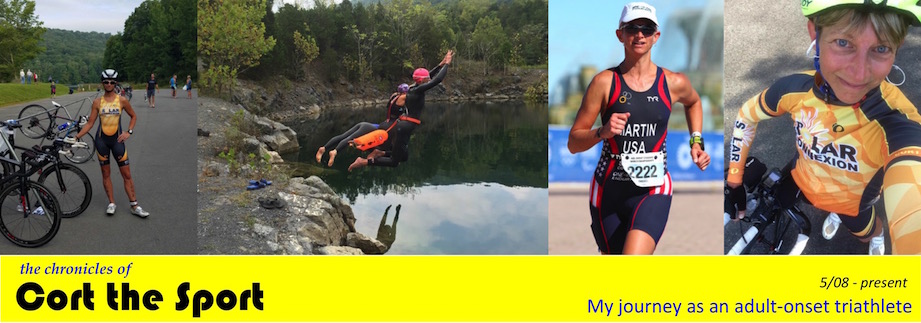Yesterday morning I had a particularly good swim session in our group with Coach Tom. I generally wear my Garmin 910 and beyond being trusty lap counter, it tracks strokes, distance and time. Like always, I uploaded the data, but for the first time, I happened to notice that Garmin Connect showed my average stroke count per length over the course of the entire workout. I hadn't paid attention before, but that number was 11. The workout included a mix of everything from aerobic sets to full-out fast 50s.
Curious, I went back through my swims from April, when I got the watch, and noticed that most of my swims had been averaging 12 or 13 strokes per length prior to January. Since January, that number has been 10 or 11. And in the last few weeks my fast 50s and 100s have been at the "faster" end of the spectrum for me.
Since I started with the group in December, Tom has had me working on developing a more complete stroke through to the finish. I know that quicker arm turnover and cadence are often emphasized for open water triathlon swims, but at some point it just becomes inefficient churn. There's a tradeoff there. And better to crank up the cadence on a more effective stroke.
I can only speak from my own perspective, in my clumsy I-didn't-grow-up-swimming words, but in my case taking a step back right now and working to get more out of my stroke has felt like the right thing. When challenged to lengthen and finish it, I have to get as much power and distance as I can. With that shift in focus, awareness of my interaction with the water has changed. I seek the pressure of the water rather than just seeing how fast I can move my arm through it. (I'm back on the Vasa Swim Ergometer weekly, and I also find that contributes to the ability to generate and sustain power. The Power Meter tells the tale! See my latest blog post on the Vasa Swim Ergometer.)
Now, I'm not just gliding along in the pool with dead spots. And when I ramp up the speed the goal is to maintain the mechanics and stroke length/count, but just do it all a little more quickly. I play around with the stroke length vs cadence tradeoff. So yeah, the word on the street is "high swim cadence" but ideally not at the expense of too much distance per stroke.
I have always said that triathlon training is a multi-factorial experiment with a sample size of one...which would be "me" in my situation. I like to try new approaches and see what happens. Working on stroke effectiveness, I feel a little faster, more confident, more relaxed, and stronger. That's worth a lot!
After noticing the stroke count change, I went back and re-read a recent article in Triathlete Europe by Dan Bullock on Swim Development. In it, he shared ten indicators of swim progress in addition to the clock. The one that stuck out for me when reading it the second time:
"At a more advanced level the ability to swim slow, medium and fast, yet still take a similar number of strokes per length."Upon further investigation of my Garmin files, I have noted a smaller range of stroke counts and more consistency. (BTW, I'm an open-turner and not a flip-turner for whatever that is worth.)
February 27, 2014 - this was warmup, then 2x300 aerobic, 2x100 pace, 2x50 fast, repeated
Bullock acknowledges what many of us know -- it is a BIG challenge to improve the swim. He likened it to learning a musical instrument or language.
December 3, 2013 - higher stroke rate and less consistent
We typically measure swim progress against the clock, which can be frustrating.
"Water complicates our ability to measure things because it makes exact 100 per cent repeatable movements unlikely. Purely measuring time, laps and heart rate may not always be conclusive. I am sure that many of you have experienced those hard sprints where the effort went in but no reduction in time was found. This is notorious and sometimes swimming feels unfair because it does not always reward effort."I have certainly had those sets where I'm thinking "YEAH!!! Nailed it!" until I look at the clock.
If you are feeling a bit frustrated with the swim, maybe it's time to look at some of these other metrics. Read through the list of ten indicators and recognize that even if you swim the same speed, but with less stress or effort, you will likely fare better on the bike and run!
Sorry for the slightly rambling blog post, this one just has not come together like some do. I guess my message is just try new things like a coached group swim or different focus point for your stroke. Experiment a little with finding your way and enjoy the triathlon experiment with sample size of one....YOU!































